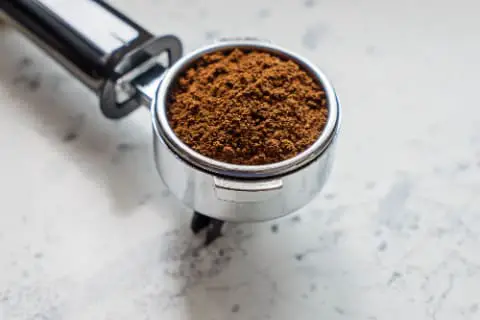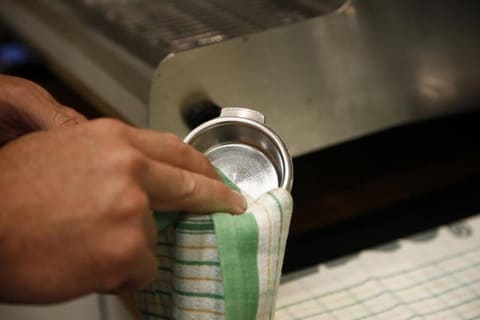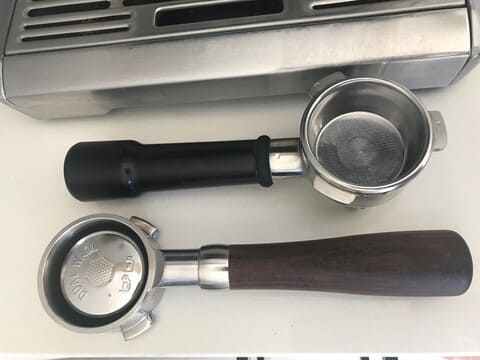As an Amazon Associate I earn from qualifying purchases. When you use our links, we may earn an affiliate commission. Learn more.
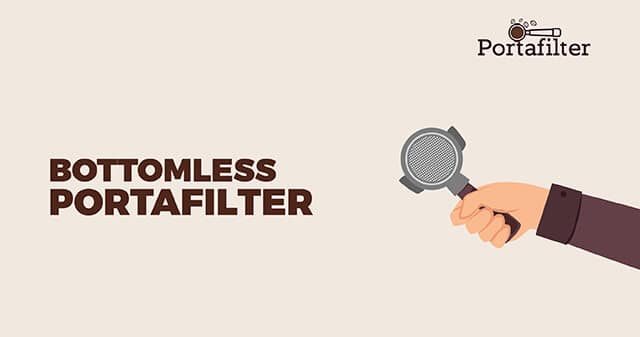
The hardest part about pulling espresso shots at home is that you have too many variables to control. Dosing, tamping, grinding, temperature, pressure — it’s so easy to mess up at least one of these factors.
The good news is, things get better with time. If you’re keen enough to identify your mistakes, you’ll eventually learn what goes into the making of a perfect shot. But the question begs itself, how can you pinpoint these mistakes? That’s where a bottomless portafilter comes in handy.
So, can a bottomless portafilter really improve your espresso? Or is it just a marketing gimmick that does nothing but makes you look like a professional barista? Let’s find out.

FAQ’s
What is a bottomless portafilter?
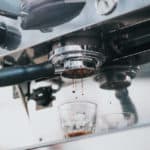
A bottomless portafilter is a normal portafilter, minus the bottom and the spout. With these parts removed, you’ll be able to see the espresso dripping from the basket directly into your cup. What are its advantages and disadvantages? That’s what I’ll explain in this post.
Why use a bottomless portafilter?
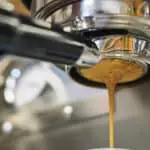
When you use a bottomless portafilter, you’ll be able to look directly at the basket’s screen. If your espresso channels, you’ll see it dripping into the cup through two or more streams rather than one central, uniform stream.
If your tamping was horrible, the espresso will even gush over the counter and maybe onto your clothes, giving you a clear warning that something is wrong with your technique.
Can a spouted portafilter provide the same explicit feedback? Never. Whether the espresso channels or gushes, it’ll flow smoothly through the spout.
Bottomless portafilter channeling

When you use a bottomless portafilter, you’ll be able to look directly at the basket’s screen. If your espresso channels, you’ll see it dripping into the cup through two or more streams rather than one central, uniform stream.
If your tamping was horrible, the espresso will even gush over the counter and maybe onto your clothes, giving you a clear warning that something is wrong with your technique.
Can a spouted portafilter provide the same explicit feedback? Never. Whether the espresso channels or gushes, it’ll flow smoothly through the spout.
But Wait, Odd Pours Aren’t Always Bad
Ask any barista and they’ll tell you — some strange pours do end up tasting quite nice. Surely not as good as a perfect, central pour, but good enough that non-experienced drinkers won’t notice the difference.
I’m not suggesting that a bottomless portafilter is unhelpful in this matter — it’ll help you perfect your process. All I’m saying is that you shouldn’t dwell too much on this process because it may not be that crucial.
What is channeling?

Channeling is one of the most annoying espresso mistakes. But before seeing how a bottomless portafilter can help, let’s quickly review why channeling happens. When you tamp the grounds, you must distribute them evenly on top of the basket’s screen. This way, the water will infuse uniformly throughout the entire puck, yielding a balanced shot with the best taste.
But what if the tamping wasn’t ideal? Or even worse, what if the grind wasn’t uniform? In these cases, water will flow through the least compact areas, or “channels”, resulting in an unbalanced shot: Water will over-extract the grounds inside the channels and under-extract the rest of the puck.
What about naked portafilters?
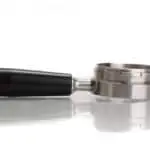
Originally, the “naked” portafilter was just another term that describes the bottomless design. Nobody knows who came up with that name, but it’s a creative way to say that these portafilters will let you see their private parts — the baskets!
In 2014, Gábor Laczkó, a Hungarian entrepreneur, launched a brand that specifically sells naked portafilters, in addition to other espresso accessories.
The only thing special about these portafilters is that you’ll see the word “NAKED” engraved on the side.
How do you make a bottomless portafilter?
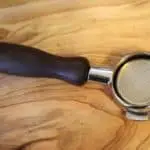
If one of your portafilters has a malfunctioning spout, you can make a bottomless portafilter by chopping it off with a metal lathe! You’ll have to be careful about the measurements, of course. But even if you messed it up, you won’t really lose that much. It’s a fun DIY project that you ought to try.
Bottomless Portafilter Benefits
1. It Provides More Clearance
If you’re trying to perfect your espresso, you should consider using a scale. Why? Well, a scale will allow you to accurately measure the dosing and the brew ratio, which should give you more intricate control over the quality of your shots. Best of all, when you pull the ultimate shot, you’ll have numerical values that can help you repeat it endlessly.
But unfortunately, some scales have thick builds that take up too much space over the drip tray. If you’re using a takeaway paper cup instead of a glass one, you’ll have even less space.
If you’re using a double-spout portafilter, you might not have enough space for both the scale and the cup. But with a bottomless model, you can stack whatever you want — you already have well enough clearance.
Some people argue that pouring espresso from that large height results in too many bubbles, but that’s a minor problem that you can resolve by tapping the cup lightly on the countertop before serving.
2. It’s Easier to Clean
After pulling shots through a spouted portafilter, you’ll have to unscrew the spout to thoroughly clean the coffee remnants. After several uses, you should also soak the whole portafilter in a professional espresso cleaner, such as Cafiza, to dissolve the hardened stains at the bottom.
And of course, the cleaning process will be much more complicated for portafilters with non-removable spouts.
With a bottomless portafilter, things are much more manageable. After you enjoy your perfect espresso, you only have to quickly flush water down the sides. And since there’s no bottom, you won’t have to use professional cleaners as often.
3. It “Might” Produce Thicker Crema
When espresso flows down a metal spout, some crema presumably sticks to the sides, detracting from the final thickness and consistency. Also, if the spout is cold, the crema will cool down and sink into the cup faster.
On the other hand, a bottomless portafilter will let the crema flow directly from the basket into your cup, yielding a somewhat thicker, richer, and better-tasting shot.
But to be honest, the extra crema is often so minimal that you might not even notice the difference.
4. It Looks Better
Alright, I’m well aware that better aesthetics isn’t a key advantage — that’s why I kept it for last.
I don’t know about you, but I love seeing espresso as it drips from each tiny hole in the basket’s screen. The way the multiple small streams join into a single one is simply mesmerizing. And the fact that the color slowly shifts from dark brown into bright gold melts my heart every time!
If you’ve never seen what I’m describing, I highly recommend checking this slo-mo video shot by James Hoffmann:
It’ll show you how the spouted and bottomless portafilters look in action so that you can judge for yourself!
Downsides of a Bottomless Portafilter
To ensure this post stays fair, I’ll mention some of the not-so-great things about a bottomless portafilter.
1. Potential Splashes
Since the bottomless portafilter drops the espresso from a higher point, you might experience minor splashing onto your countertop.
If your tamping isn’t ideal, that problem will be much more evident. The espresso will literally gush forcefully all over your kitchen and even onto your clothes.
But if you ask me, I think this isn’t really a disadvantage. If the espresso gushes, it’s your fault, not the portafilters!
You have to review your technique to see what needs improvement.
2. You Can’t Pull Two Shots
When using a double-spout portafilter, you can easily pull your shot into two cups — a bottomless model can never do that.
Then again, this shouldn’t be a major concern unless you’re a professional barista who needs to serve many customers in a short time.
Brooke Davis
Hi everyone, my name is Brooke and I’m a Barista and freelance writer. I love brewing coffee and my favorite coffee drink is without doubt an Americano (espresso with added hot water). When I’m not busy making or writing about coffee you’ll find me hanging out at the beach with friends in California where I am currently residing. Follow me on: LinkedinThis free cheat sheet will improve your coffee brew by providing quick information on brew ratio, grind size, optimal brewing time, and more.
